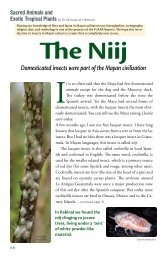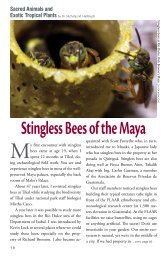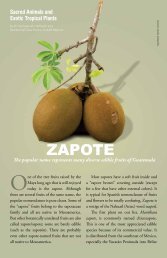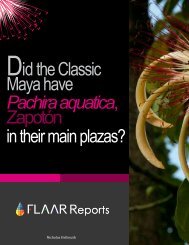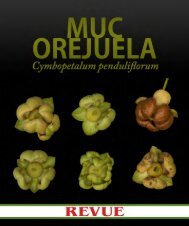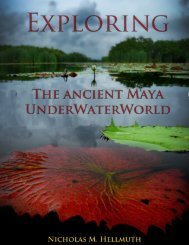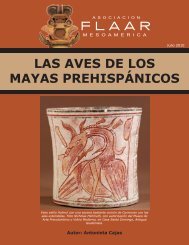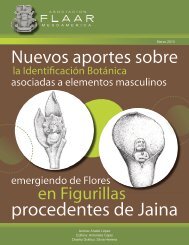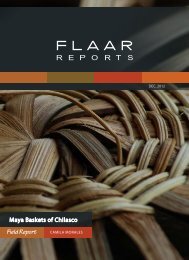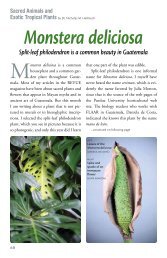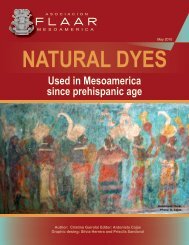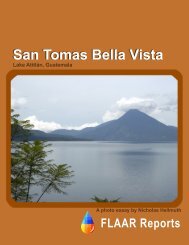download now - Maya Archaeology
download now - Maya Archaeology
download now - Maya Archaeology
Create successful ePaper yourself
Turn your PDF publications into a flip-book with our unique Google optimized e-Paper software.
Flowers of <strong>Maya</strong> Art<br />
Visible at Tikal<br />
Pachira aquatica, Zapotón<br />
Parque Nacional Tikal Peten, Guatemala<br />
Nicholas Hellmuth<br />
Pachira aquatica, Zapotón<br />
Parque Nacional Tikal Peten, Guatemala<br />
1
Introduction: Flowers in Murals and Paintings of the <strong>Maya</strong><br />
In my PhD dissertation I wrote about the most commonly pictured flower in <strong>Maya</strong> art, the white<br />
water lily. Now, twenty-seven years later I am still doing research on flowers in <strong>Maya</strong> art. Over<br />
the past several years I have worked in the library and out in the field to complete my list of<br />
sacred flowers, edible flowers, and flowers that are related to <strong>Maya</strong> culture of Guatemala. Most<br />
of these flowers, plants, and trees are also associated with the <strong>Maya</strong> art of Mexico, Honduras,<br />
and El Salvador as well.<br />
My list of all flowers which could potentially be of interest to archaeologists, iconographers,<br />
and epigraphers is in an annual report of FLAAR for 2010-2011. One of these flowers is<br />
Pachira aquatica. The fruit is called zapotón. There is a separate list of flowers from<br />
independent research of Charles Zidar. One of the FLAAR photographs of a flower painted on<br />
a vase is utilized in his article. Otherwise we worked independently. But since by coincidence<br />
we <strong>now</strong> both reside in St Louis, Missouri, we are exchanging notes <strong>now</strong>.<br />
In Belize Pachira aquatica may be called money tree, provision tree, shaving brush tree (based<br />
on shape of the flower), or water chestnut.<br />
I have yet to see any local people use this tree, but spend an hour on the Internet and you will<br />
find that many products can be made from different parts of this tree:<br />
2<br />
Seed oil with industrial potential for manufacturing soap. Young leaves and flowers<br />
are eaten as a vegetable. Wood is white and soft, suitable for manufacturing paper,<br />
yielding 36% cellulose paste. Bark is used for caulking boats and cordage and yields<br />
a dark red dye. Bark is also used medicinally to treat stomach complaints and head<br />
aches while a tisane from the boiled bark is used for blood tonic. Suitable for live<br />
fence posts and street trees, it is also planted as an ornamental species<br />
(www.fao.org/docrep/V8929e/v8929e06.htm). This is in addition to the seeds being<br />
edible.<br />
And I would continue to stress the enticing fragrance of the flowers, even when dead and<br />
having been on the ground several days.<br />
Also may be<br />
interested in<br />
<strong>Maya</strong><br />
Ethnobotany<br />
complete<br />
inventory<br />
Pachira aquatica, Zapotón<br />
Parque Nacional Tikal Peten, Guatemala<br />
3
Pachira aquatica trees at Tikal<br />
The trees at Tikal are a bit taller than those of AutoSafari Chapin but not as tall as those of<br />
Rio Dulce (over 12 meters high along the shores of the river in the Izabal area). The book<br />
by Tracey Parker, Trees of the <strong>Maya</strong>, lists heights up to 15 to 20 meters. I have not noticed<br />
any that high. 20 meters is the height of a seven story office building. Even 15 meters is the<br />
height of a five story apartment building. Most of the trees are about 7 to 9 meters (at most<br />
the height of a three story building).<br />
Her book is based on compliations of Standley and other early botanists; it is unlikely the<br />
author herself has inspected each of the thousands of trees in her book. But even if<br />
primarily a compilation, her book is so much easier to utilize than the early Chicago<br />
Museum of Natural History monographs with their endless list of synonyms and botanical<br />
jargon. Plus, her book has all trees within one single volume, and most of the major species<br />
are illustrated.<br />
The altitude of Tikal’s aguada is over 200 meters above sea level. The main plaza is about<br />
243 meters (if I can remember my measurements from 1965, which is a tough task for my<br />
brain cells so many decades afterwards). Rio Dulce is probably less than 50 meters above<br />
sea level (I am making a guess).<br />
Zapotón is listed in the tabulation of Luis Villar ‘s enjoyable book on the culturally<br />
remarkable percent of trees of Guatemala (p. 143), but there is no chapter on the Pachira<br />
aquatica or even a photograph of the lovely flower. Considering the enticing fragrance of<br />
this flower, and its other properties, for a book on Arboles Magicos y Notables, it is<br />
unfortunate that this flower and tree is absent.<br />
Zapotón is totally absent from “Animals & Plants of the Ancient <strong>Maya</strong>” by Victoria<br />
Schlesinger (2001). The absence of many crucial plants in such an oft-touted book is<br />
precisely why I have spent so many years building up a research library on plants (and<br />
animals) and launching our two educational web sites: www.maya-ethnobotany.org and<br />
www.maya-ethnozoology.org. But Schlesinger does provide excellent drawings of the<br />
animals and plants that she did select.<br />
Pachira aquatica, Zapotón<br />
Parque Nacional Tikal Peten, Guatemala<br />
5
The fruit in Guatemala is smooth: not ridged; not like a cacao<br />
An illustration of a Pachira aquatica tree with flower and three fruits (Peixoto and Escudiero 2002:127),<br />
shows the flower more or less acceptably, though the buds are longer and rounded at the end (not sharp).<br />
But the fruit in their drawing is the precise proportions of a cacao; and not at all the correct size, shape, or<br />
outside smoothness of a zapoton fruit of Guatemala. Perhaps the fruits in Brazil are ridged?<br />
In fact if you search out more photos of Pachira aquatica fruits in South America you see that they look<br />
precisely like a cacao pod. /www.flickriver.com/photos/kanakoa/tags/bombacaceae/ Indeed they are even<br />
sometimes called fake cacao. But these are the South American ones. All the Guatemalan fruits are much<br />
much larger and totally smooth: no ridges whatsoever. There are separate FLAAR Reports on Pachira<br />
aquatica along Rio Dulce and especially Pachira aquatica at AutoSafari Chapin where we show the fruits<br />
in high resolution photographs.<br />
The Pachira aquatica fruits shown for Nicaragua have shallow but still clearly defined flutes (http://fm2.<br />
fieldmuseum.org/plantguides/view.asp?chkbox=1467) . So evidently the fruits are smooth in the north and<br />
fluted like cacao in South America. Halfway in between north and south, the fruits are halfway fluted!<br />
Most fruits are onlong, but occasionally are spherical http://biogeodb.stri.si.edu/biodiversity/<br />
species/26628/<br />
The flowers of Pachira aquatica are harvested by leaf-cutting ants<br />
In the remarkable historical narration of the Popol Vuh, the Hero Twins utilize leaf-cutting ants to harvest<br />
and carry four different colors of flowers. Since one of the botanical research interests of FLAAR is to find<br />
all plants and animals out in the real world that are featured in the Popol Vuh, I am always on the lookout<br />
for leaf-cutting ants carrying flowers. During the last three years I have found leaf-cutting ants carrying<br />
flowers near Sayaxche (Posada Caribe), at Las Guacamayas research station (Rio San Pedro Martyr,<br />
Peten), and near Rio Dulce, Izabal.<br />
Thus it was of special interest to find Pachira aquatica being cut up and carried off by leaf-cutting ants at<br />
Tikal. You can see this around the aguada at Tikal (behind the museum of stelae). Just be careful near the<br />
shore: there are crocodiles in this aguada.<br />
In order to document the Pachira aquatica flower being harvested by the zompopos, we show those high<br />
resolution photographs in a separate PDF (otherwise the present PDF would be too large a file size). The<br />
camera we are using is a 21 megapixel Phase One P25+ and/or a 21 megapixel Canon EOS-1Ds Mark<br />
III.<br />
Leaf-cutting ants are called zompopo in local Guatemalan Spanish.<br />
6
Pachira aquatica, Zapotón<br />
Parque Nacional Tikal Peten, Guatemala<br />
7
Bombacaceae, a tree family of interest for <strong>Maya</strong>nists<br />
Pachira is only one genus of the fascinating family of trees, the Bombacaceae. The genus<br />
Ceiba is another member of the Bombacaceae. We have separate reports on Ceiba trees<br />
which we have found and photographed elsewhere in Guatemala and El Salvador.<br />
Below is a list of the other genus of trees. In addition to Pachira aquatica, we are particular<br />
interested in Pseudobombax, Quararibea and other ceiba species.<br />
Bernoullia<br />
Bombax<br />
Ceiba<br />
Chorisia, but is not native to Guatemala.<br />
Ochroma<br />
Pachira<br />
Pseudobombax<br />
Quararibea<br />
Many of the trees of this family have conical spines, but not all. Many of the flowers are similar<br />
to that of Pachira aquatica, but by no means all. For example, the flowers of Ceiba pentandra<br />
are totally different. We are preparing a separate FLAAR Report which will be a comparative<br />
tabulation of all trees, of each genus in Mesoamerica which has conical or comparable spines<br />
on the trunk. This tabulation will indicate which flowers have a structure similar to the flowers<br />
of Pachira aquatica, and which flowers are totally different.<br />
Only a small percent of Pachira aquatica trees have spines on their trunk. Yes, I have seen<br />
one or two at AutoSafari Chapin and one tree along Rio Dulce with spines. But there are other<br />
trees, such as many many species of the genus Zanthoxylum, which have larger and more<br />
impressive spines. Some of the Zanthoxylum species we show in other FLAAR Reports. There<br />
are so many of these trees that it will take another year to track them all down and photograph<br />
each species.<br />
It would be interesting to do more research in the Parque Nacional Tikal to see how many of<br />
the trees, which are related to Pachira aquatica, or related to Ceiba, are native to this part of<br />
Guatemala.<br />
Some of these trees, such as Quararibea have remarkable properties. To find these in Tikal<br />
would be wonderful.<br />
8
Pachira aquatica, Zapotón<br />
Parque Nacional Tikal Peten, Guatemala<br />
9
Tikal offers flowers and animals, in addition to <strong>Maya</strong><br />
monuments<br />
The art of the Classic <strong>Maya</strong> pictures jaguars, macaws, spider monkeys, insects,<br />
scorpions and other creatures, especially in their paintings on vases, bowls, and<br />
plates. The artists over a thousand years ago frequently painted images of flowers.<br />
Indeed in the Tomb of the Jade Jaguar, Burial 196, which I discovered and excavated<br />
in 1965, there were paintings of stylized flowers, and of a vase showing a man<br />
smoking a cigar. So plants (tobacco and the other ingredients of <strong>Maya</strong> cigars a<br />
thousand years ago, such as guarumo leaves), and flowers, are a part of <strong>Maya</strong><br />
archaeology. This means that the local guides can provide additional k<strong>now</strong>ledge to<br />
tourists when they add comments about the role of plants, flowers and animals in<br />
<strong>Maya</strong> religion, mythology, and art.<br />
So one of our goals is to provide the local guides, and the visitors, the raw material,<br />
so the role of flowers, tree spines, and sacred birds are easier to explain to visitors.<br />
Plus naturally we wish to assist scholars, and students, with a data base of usable<br />
photographs, so they can continue study of the hieroglyphs which picture or talk<br />
about sacred flowers and referred animals.<br />
But there is much more than the archaeological and artistic aspect of sacred<br />
creatures. There is the raw reality of the actual tropical rain forest.<br />
Mirtha Cano has worked to spread the message, that “the Parque Nacional Tikal<br />
offers the visitor, national and international, so much more, in addition to the famous<br />
<strong>Maya</strong> ruins.<br />
Tikal offers remarkable plants, flowers, vines, fruits; and of course gorgeous birds,<br />
fascinating animals. I must admit that I find even the spiders and insects wonderful<br />
examples of the beauty provided on earth by Mother Nature.<br />
Thus our goal at FLAAR is to utilize our experience as photographers, and our<br />
long-term interest in studying the flora and fauna of Mesoamerica, to provide a<br />
message for students, scholars, and the general public, that Guatemala is worth<br />
visiting to see, and experience, the trees, flowers and animals of the tropical world.<br />
For these reasons we have done the photography of Pachira aquatica around the<br />
aguada (water reservoir) in the Parque Nacional Tikal). And <strong>now</strong>, with this<br />
publication, we can bring this information to the world.<br />
There is no cost to the reader; this report is for you to read, enjoy, and learn from.<br />
Pachira aquatica, Zapotón<br />
Parque Nacional Tikal Peten, Guatemala<br />
11
Protection of the natural<br />
eco-systems: protecting Pachica<br />
aquatica trees<br />
When hotels and marinas are built along the rivers and<br />
lakes of Guatemala, Mexico, Guatemala, and Central<br />
America, it would help if Pachira aquatica trees were<br />
not slaughtered with chain saws and bulldozers. The<br />
tree is so beautiful it will help attract tourists, both local<br />
and foreign. Plus, this tree is a reminder of the sacred<br />
cultures of the ancestors of the <strong>Maya</strong> people.<br />
And, even more important for future generations, the<br />
Pachira aquatica tree is a part of the natural<br />
eco-system. It is rather senseless to pour concrete<br />
and asphalt across the fragile coastal eco-systems. In<br />
many countries of the world endangered eco-systems<br />
are<br />
protected either by law, or by respect by individuals<br />
who wish to avoid senselessly destroying the flora<br />
and fauna of the natural world. Thus it is helpful that<br />
lakes such as Yaxha and Sacnab are protected, and<br />
that parks such as Tikal can help preserve the natural<br />
beauty of Guatemala.<br />
12
Pachira aquatica, Zapotón<br />
Parque Nacional Tikal Peten, Guatemala<br />
13
Ack<strong>now</strong>ledgements<br />
…..<br />
Bibliography<br />
Our complete bibliography is in the first opus listed below.<br />
HELLMUTH, Nicholas M.<br />
2001 <strong>Maya</strong> Ethnobotany Complete Inventory: fruits, nuts, root<br />
crops, grains, construction materials, utilitarian uses, sacred plants,<br />
sacred flowers: Guatemala, Mexico, Belize, Honduras. 9th edition.<br />
FLAAR Reports.<br />
PEIXOTO, Ariane Luna and Alexandra ESCUDEIRO<br />
2002 Pachira aquatica (Bombacaceae) na obra “História dos<br />
Animais e Árvores do Maranhão” de Frei Cristóvão de Lisboa.<br />
Rodriguésia 53 (82): 123-130. Available on-line.<br />
de RIOJAS, Regina Aquirre and Elfriede de PÖLL<br />
2007 Trees in the life of the <strong>Maya</strong> World. Botanical Research<br />
Institute of Texas. 206 pages.<br />
SCHLESINGER, Victoria<br />
2000 Animals & Plants of the Ancient <strong>Maya</strong>. A Guide. University of<br />
Texas Press. 351 pages.<br />
VILLAR ANLEU, Luis<br />
2006 Guatemala Arboles Magicos y Notables. Artemis Edinter<br />
Editores, Guatemala City.<br />
ZIDAR, Charles and Wayne ELISENS<br />
2009 Sacred Giants: Depiction of Bombacoideae on <strong>Maya</strong><br />
Ceramics in Mexico, Guatemala, and Belize. Economic Botany, Vol.<br />
63, No. 2, pp. 119-129.<br />
14
Pachira aquatica, Zapotón<br />
Parque Nacional Tikal Peten, Guatemala<br />
15
Pachira aquatica, Zapotón<br />
Parque Nacional Tikal Peten, Guatemala<br />
Special thanks<br />
Photographs were taken with respective permission as part of a cooperative program betwenn<br />
Biology Unit of Tikal National Patrk trough the General Direction of the Cultural and Natural<br />
Heritage, whereby FLAAR Mesoamerica provides free photography to the park programs and<br />
FLAAR Mesoamerica provides enlargements for photo exhibits for the park museums.<br />
We appreciate the permission to undertake photography of flora and fauna related to the <strong>Maya</strong><br />
culture. Specially to M.S. Erick Ponciano General Director of the Cultural and Natural Heritage and<br />
Mirtha Cano, biologyst and Coordinadora de la unidad de biología at the park. Tikal is a UNESCO<br />
World Heritage Site in addition to being a reserve for endangered plants and animals.<br />
For visitors who wish to consider coming to Guatemala as tourists, we highly recommend you are<br />
aware of the natural beauty of the flora and fauna of Mesoamerica. The national parks of<br />
Guatemala are justifiably world heritage sites for their pre-Columbian civilization, but these parks,<br />
especially the Tikal park and the Lake Yaxha park, have even more value as reservoirs of plant and<br />
animal diversity.<br />
16



